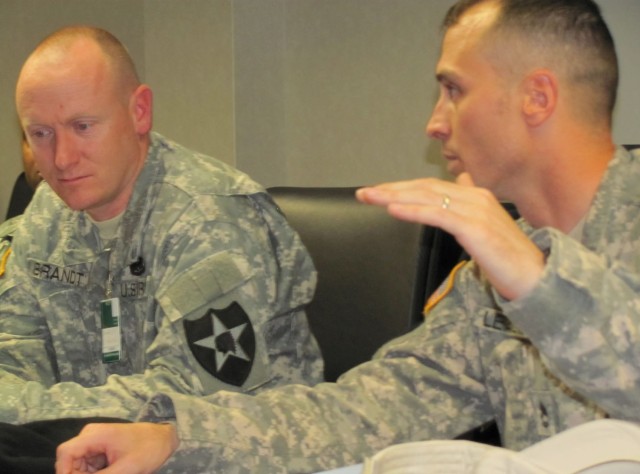WARREN, Mich. (Nov. 23, 2010) -- U.S. Army I Corps Soldiers who recently returned from the theater of operations in Afghanistan provided system input from a warfighter's perspective to the project management office, Stryker Brigade Combat Team, at a meeting Nov. 9.
The total life cycle of the full range of Stryker combat vehicles is managed by PM SBCT which designs, develops, produces, fields and sustains the systems for the U.S. Army.
"Recently-returning Soldiers provide the freshest data point to apply to ground combat systems development," Col. Robert Schumitz, project manager SBCT, said. "This open forum for exchanging information is essential in the communication process. The opportunity also serves as a great interface for career civilians who generally don't get the opportunity to converse one-on-one with Stryker Soldiers."
Soldiers offered their opinions and addressed topics dealing with the system's functionality, space, power, cooling, climate control, seating, mobility, and even maintenance support.
"What the Soldiers have voiced is consistent with what we've heard before," Maj. Michael Sansone, assistant product manager for Stryker fleet management said. "We listen to them and put out the requirements to meet their needs while serving the Army's purpose."
What are Soldiers saying about the Stryker'
"My two weeks on the combat vehicle were sensational," Sgt. 1st Class Mark Leavens said. "It's good to have a vehicle that could keep up with maneuvers."
"There was no getting comfortable in the (mine blast) seats," Sgt. 1st Class Erik Knight said. "I can deal with the discomfort, though, if the seats are going to work. The seats did their job well."
"The Stryker has great cross-country mobility," Sgt. 1st Class James Brandt said. "With all the kits, it took a little longer to get up to speed, but it was no problem once we got there."
"The maintenance support was awesome," Knight said. "The GDLS (General Dynamics Land Systems) guys were great for onsite repairs."
The Soldiers also made recommendations for enhancing the length of battery power, the suspension, wheel hubs, and infrared lighting.
"The engineers really absorbed the information," Maj. Darin Stevens, assistant product manager for double v-hull testing, said. "The Soldiers provided great feedback to help us improve the Stryker."
Because of the mountainous terrain in Afghanistan, the maneuverability of the Strykers makes them ideal for transporting the Soldiers safely and effectively to and from their destination.
"In a reliable, survivable and supportable system, Soldiers are able to keep their eyes on the objective, secure the area, and then move back into the forward operating base," Maj. Terry Phillips, assistant product manager for Stryker integration, said.
What's next for Stryker'
"We are focused on the future," Schumitz said. "The Stryker was once a vision called the interim armor vehicle. It is now a reality that will take us into the foreseeable future."


Social Sharing